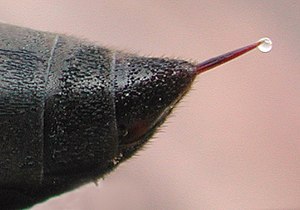
Venom or zootoxin is a type of toxin produced by an animal that is actively delivered through a wound by means of a bite, sting, or similar action.[1][2][3] The toxin is delivered through a specially evolved venom apparatus, such as fangs or a stinger, in a process called envenomation.[2] Venom is often distinguished from poison, which is a toxin that is passively delivered by being ingested, inhaled, or absorbed through the skin,[4] and toxungen, which is actively transferred to the external surface of another animal via a physical delivery mechanism.[5]
Venom has evolved in terrestrial and marine environments and in a wide variety of animals: both predators and prey, and both vertebrates and invertebrates. Venoms kill through the action of at least four major classes of toxin, namely necrotoxins and cytotoxins, which kill cells; neurotoxins, which affect nervous systems; myotoxins, which damage muscles; and haemotoxins, which disrupt blood clotting. Venomous animals cause tens of thousands of human deaths per year.
Venoms are often complex mixtures of toxins of differing types. Toxins from venom are used to treat a wide range of medical conditions including thrombosis, arthritis, and some cancers. Studies in venomics are investigating the potential use of venom toxins for many other conditions.
- ^ "venom" at Dorland's Medical Dictionary
- ^ a b Gupta, Ramesh C. (24 March 2017). Reproductive and developmental toxicology. Saint Louis. pp. 963–972. ISBN 978-0-12-804240-3. OCLC 980850276.
{{cite book}}: CS1 maint: location missing publisher (link) - ^ Chippaux, JP; Goyffon, M (2006). "[Venomous and poisonous animals--I. Overview]". Médecine Tropicale (in French). 66 (3): 215–20. ISSN 0025-682X. PMID 16924809.
- ^ "Poison vs. Venom". Australian Academy of Science. 3 November 2017. Retrieved 17 April 2022.
- ^ Nelsen, D. R., Nisani, Z., Cooper, A. M., Fox, G. A., Gren, E. C., Corbit, A. G., & Hayes, W. K. (2014). "Poisons, toxungens, and venoms: redefining and classifying toxic biological secretions and the organisms that employ them". Biological Reviews, 89(2), 450-465. doi:10.1111/brv.12062. PMID: 24102715.